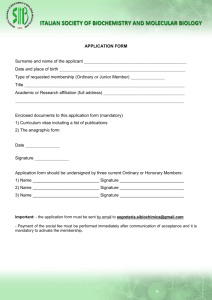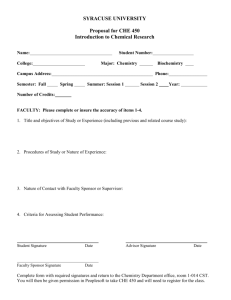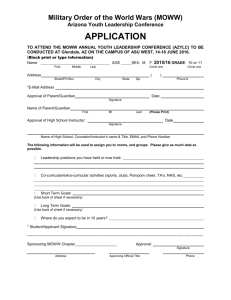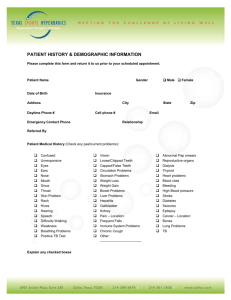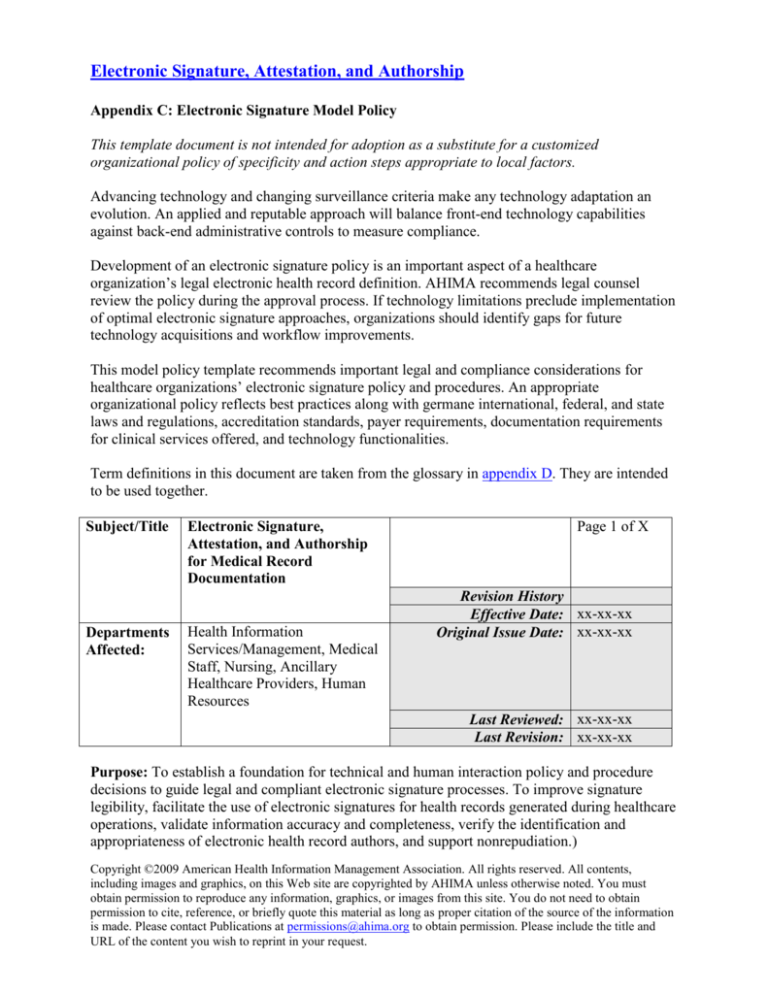
Electronic Signature, Attestation, and Authorship
Appendix C: Electronic Signature Model Policy
This template document is not intended for adoption as a substitute for a customized
organizational policy of specificity and action steps appropriate to local factors.
Advancing technology and changing surveillance criteria make any technology adaptation an
evolution. An applied and reputable approach will balance front-end technology capabilities
against back-end administrative controls to measure compliance.
Development of an electronic signature policy is an important aspect of a healthcare
organization’s legal electronic health record definition. AHIMA recommends legal counsel
review the policy during the approval process. If technology limitations preclude implementation
of optimal electronic signature approaches, organizations should identify gaps for future
technology acquisitions and workflow improvements.
This model policy template recommends important legal and compliance considerations for
healthcare organizations’ electronic signature policy and procedures. An appropriate
organizational policy reflects best practices along with germane international, federal, and state
laws and regulations, accreditation standards, payer requirements, documentation requirements
for clinical services offered, and technology functionalities.
Term definitions in this document are taken from the glossary in appendix D. They are intended
to be used together.
Subject/Title
Departments
Affected:
Electronic Signature,
Attestation, and Authorship
for Medical Record
Documentation
Health Information
Services/Management, Medical
Staff, Nursing, Ancillary
Healthcare Providers, Human
Resources
Page 1 of X
Revision History
Effective Date: xx-xx-xx
Original Issue Date: xx-xx-xx
Last Reviewed: xx-xx-xx
Last Revision: xx-xx-xx
Purpose: To establish a foundation for technical and human interaction policy and procedure
decisions to guide legal and compliant electronic signature processes. To improve signature
legibility, facilitate the use of electronic signatures for health records generated during healthcare
operations, validate information accuracy and completeness, verify the identification and
appropriateness of electronic health record authors, and support nonrepudiation.)
Copyright ©2009 American Health Information Management Association. All rights reserved. All contents,
including images and graphics, on this Web site are copyrighted by AHIMA unless otherwise noted. You must
obtain permission to reproduce any information, graphics, or images from this site. You do not need to obtain
permission to cite, reference, or briefly quote this material as long as proper citation of the source of the information
is made. Please contact Publications at permissions@ahima.org to obtain permission. Please include the title and
URL of the content you wish to reprint in your request.
Scope: Electronic signature, attestation, and authorship are referred to in this document as esignature. Individuals authorized to affix an electronic signature to medical record
documentation shall be limited to individuals with defined privileges to document in the medical
record, such as treating physicians, other clinicians, ancillary healthcare staff, and clinical
residents and students.
Policy Statement: Electronic signature is used for health records as a means of attestation of
electronic health record entries, transcribed documents, and computer-generated documents.
Properly executed electronic signatures are considered legally binding as a means to identify the
author of health record entries, confirm content accuracy and completeness as intended by the
author, and to ensure e-signature integrity is maintained for the life of the electronic health
record.
It is the policy of the healthcare organization to accept electronic signatures as defined within
this policy for author validation of documentation, content accuracy and completeness with all
the associated ethical, business, and legal implications. This process operates within a secured
infrastructure, ensuring integrity of process and minimizing risk of unauthorized activity in the
design, use, and access of the electronic health record.
Definitions
Attestation: the act of applying an electronic signature to the content, showing authorship and
legal responsibility for a particular unit of information.
Authentication: the security process of verifying a user’s identity with the system that
authorizes the individual to access the system (i.e., the sign-on process). Authentication shows
authorship and assigns responsibility for an act, event, condition, opinion, or diagnosis.
Authorship: attributing the origination or creation of a particular unit of information to a
specific individual or entity acting at a particular time.
Electronic signature: a generic, technology-neutral term for the various ways that an electronic
record can be signed, including a digitized image of a signature, a name typed at the end of an email message by the sender, a biometric identifier, a secret code or PIN, or a digital signature.
Policy
The policy defines the components and elements that make up the healthcare organization’s
approved approach to e-signature.
1. Electronic Signature Authentication
a. General Principles
Current laws and regulations (international, federal, and state), accreditation standards,
and payer and local policies and requirements are taken into account in developing
Copyright ©2009 American Health Information Management Association. All rights reserved. All contents,
including images and graphics, on this Web site are copyrighted by AHIMA unless otherwise noted. You must
obtain permission to reproduce any information, graphics, or images from this site. You do not need to obtain
permission to cite, reference, or briefly quote this material as long as proper citation of the source of the information
is made. Please contact Publications at permissions@ahima.org to obtain permission. Please include the title and
URL of the content you wish to reprint in your request.
organizational policy to ensure compliance at all levels.
E-signature policy is set by a multidisciplinary group or committee knowledgeable in the
laws, technology, ethics, and best practices, such as those identified in the approvals
signature section at the end of this document. A carefully defined approvals protocol
ensures concurrence by all positions and areas responsible for establishing and
maintaining a reputable approach to electronic signature.
New EHR software acquisition decisions include due diligence to assess functional
capability to uphold the organization’s e-signature requirements.
Periodic software updates and upgrades include pre-implementation investigation of
design differences or changes impacting a valid, legal approach to e-signature. As
technology and software improvements strengthen the e-signature process, policy, and
procedure, documents are updated and staff training refreshers carried out.
Verification of content accuracy and completeness of each entry or document is made by
the author prior to attestation.
An e-signature event captures and displays the e-signature, author’s name, credentials,
date, and time of application.
Once an entry has been electronically signed, the system prevents deletion or alteration of
the entry and its related electronic signature for the life of the referenced documentation.
The policy addresses an organization’s acceptable timeliness parameters related to an esignature application. Factors such as germane laws, regulations, accreditation standards,
and operational factors would be considered in an organization’s definitions.
Up-to-date policy and procedures are readily accessible by all e-signature users. Staff
communication and training includes timely updates of policy and procedural changes.
The policy addresses acceptability of imported electronic documents with an e-signature
component into the EHR and legal health record. If the type and method of e-signature on
an external document is a decision-making factor to allow import of a document, the esignature policy addresses its alignment with the organization’s separate policy for
management of external documents.
b. Types of E-Signatures
The policy delineates the types of e-signature functionality acceptable for use in the
organization and the method of organization approval of each type prior to initial use.
A properly executed electronic process signifying an approval of an entry or document
content presented in electronic format may encompass a broad gamut of technologies and
methodologies, ranging from an “I agree” button in a click-through agreement, to an
Copyright ©2009 American Health Information Management Association. All rights reserved. All contents,
including images and graphics, on this Web site are copyrighted by AHIMA unless otherwise noted. You must
obtain permission to reproduce any information, graphics, or images from this site. You do not need to obtain
permission to cite, reference, or briefly quote this material as long as proper citation of the source of the information
is made. Please contact Publications at permissions@ahima.org to obtain permission. Please include the title and
URL of the content you wish to reprint in your request.
electronic tablet that accepts a handwritten digitized signature, to a digital signature
cryptographically tied to a digital ID or certificate.
An electronic signature approach or proposed software design is formally approved by a
multidisciplinary body prior to first use, such as the medical record committee or an EHR
governance committee. A written proposal accompanied by a functional demonstration is
recommended as part of the investigation and approval process.
Acceptable and approved functional types may include:
Biometric: use of biological data, such as fingerprints, handprints, retinal scans, and pen
strokes, to authenticate an individual.
Digital signature: a cryptographic signature (a digital key) that authenticates the user,
provides nonrepudiation, and ensures message integrity. This is the strongest signature
because it protects the signature by a type of “tamper-proof seal” that breaks if the
message content were to be altered.
Digitized signature: an electronic representation of a handwritten signature. The image
of a handwritten signature may be created and saved using various methods, such as
using a signature pad, scanning a wet signature, or digital photography. The signature
may be “captured” in real time (at the time the user applies the signature), or a saved
image captured at the point of normal business operations may be imported. The digitized
signature is useful for patient signatures that must be collected for admission consent,
surgical consent, authorizations, discharge instructions, advance directives, and generally
any other type of electronic form requiring patient signature.
c. Data Elements Required in E-Signature
Policy defines the screen visual and hard-copy appearance of the applied e-signature for
user and legal identification.
The e-signature line includes the author’s e-signature, full name, credentials, date, and
time of e-signing.
Accompanying signature phrases approved and acceptable for EHR authentication
statements are identified. Phrases selected should be fitting to the type of documentation
referenced. Examples include “Electronically signed by”; “Signed by”; “Authenticated
by”; “Sealed by”; “Data entered by”; “Approved by”; “Completed by”; “Verified by”;
“Finalized by”; “Validated by”; “Generated by”; and “Confirmed by.”
d. Amendments, Corrections, Deletions, and Retractions in the EHR
Policy defines the provider’s electronic approach to amendments, corrections, deletions,
and retractions in keeping with legal principles. Any necessary revisions to an
electronically signed document must follow organizational policy and procedure. These
Copyright ©2009 American Health Information Management Association. All rights reserved. All contents,
including images and graphics, on this Web site are copyrighted by AHIMA unless otherwise noted. You must
obtain permission to reproduce any information, graphics, or images from this site. You do not need to obtain
permission to cite, reference, or briefly quote this material as long as proper citation of the source of the information
is made. Please contact Publications at permissions@ahima.org to obtain permission. Please include the title and
URL of the content you wish to reprint in your request.
changes require the same data elements described in the “Types of E-Signatures”
section. Please refer to two toolkits, “Amendments, Corrections, and Deletions in the
Electronic Health Record Toolkit” and Amendments, Corrections, and Deletions in
Transcribed Reports Toolkit,” for recommended procedures.
Addendum: new documentation added to original entry. Addendums should be timely
and bear the current date and reason for the additional information being added to the
health record.
Amendment: documentation meant to clarify health information within a health record.
An amendment is made after the original documentation has been completed by the
provider. All amendments should be timely and bear the current date of documentation.
Correction: a change in the information that is meant to clarify inaccuracies after the
original documentation has been signed or rendered complete.
Deletion: the act of eliminating information from previously closed documentation
without substituting new information.
Late entry: delayed EHR documentation. The entry pertains to the regular course of
business for the patient it addresses but is recorded subsequent to the usual and customary
point-of-care documentation timeliness. The delay often creates documentation
sequencing outside of normal chronological order.
Retraction: the act of correcting information that was inaccurate, invalid, or made in
error and preventing its display or hiding the entry or documentation from further general
view. After an entry or document has been invalidated, it must be retained in a retracted
state in the version control portion of the legal health record for access if needed for legal
or other purposes. Organizational policy should provide guidelines on when a correction
is made versus retraction.
2. Special Consideration for E-Signature
Variation in technology implemented and services offered may require policy coverage of
multiple provisions for special e-signature practices. Policy defines the necessary approaches and
approved functionalities.
a. Electronic Dual Signatures, Cosignatures, and Countersignatures
Definitions of the three synonyms: Additional or supplemental signature(s),
electronically affixed, in those instances where state or federal law, academic teaching
programs, facility guidelines, or clinical preference call for multiple attestations on a
particular unit of information.
For example, a resident may dictate, edit, and sign a document to indicate authorship. The
responsible supervising physician may be required to sign the document in addition to the
Copyright ©2009 American Health Information Management Association. All rights reserved. All contents,
including images and graphics, on this Web site are copyrighted by AHIMA unless otherwise noted. You must
obtain permission to reproduce any information, graphics, or images from this site. You do not need to obtain
permission to cite, reference, or briefly quote this material as long as proper citation of the source of the information
is made. Please contact Publications at permissions@ahima.org to obtain permission. Please include the title and
URL of the content you wish to reprint in your request.
resident. Recommended e-signature practices for dual signatures, cosignatures, and
countersignatures are included in the toolkits “Amendments, Corrections, and Deletions
in the Electronic Health Record Toolkit” and “Amendments, Corrections, and Deletions
in Transcribed Reports Toolkit.”
In the case of transcribed documents, the point at which the e-signature is affixed is the
point at which the document is locked for editing changes. After e-signing, the
amendments, corrections, and deletions procedures are employed.
b. Entries Made on Behalf of Another
At the point of care. If documentation of care is recorded by one individual for another
when both are present, such as in a scribe role or an emergency trauma or code event, the
e-signature capture should include identifying information of both individuals. At a
minimum, the identification of the person who documented the information, the date, and
time should be captured, along with an attestation e-signature of the ultimately
responsible caregiver noting corresponding date and time of attestation. Title identity
should be clearly noted respectively for each e-signature (e.g., scribe versus caregiver).
For final health record completion. In the event a physician or other clinical provider is
protractedly absent leaving unsigned electronic documents or entries, a process is in place
to invite qualified alternate signers for purposes of record closure. A qualified alternate
signer is one who is able to uphold the purpose of attestation, that of familiarity with the
clinical case who can validate the accuracy of the documentation. When entries must be
left unsigned due to case unfamiliarity by other caregivers and lack of alternate signers,
explanatory documentation is included in the EHR to indicate the reason for record
closure with e-signature validation gaps.
c. Proxy, Alternate, or Group Signatures
The process by which another provider is authorized to electronically sign documentation
on behalf of the original author in an ongoing manner. The proxy accepts responsibility
for the content of the original documentation. The use of proxy signature technology
should be monitored to ensure the purpose of e-signature is upheld.
d. Multiple Signatures
Entries or reports containing documented contributions by multiple individuals must be
authenticated by each contributor in a way that unambiguously identifies each
individual's specific contribution. Multiple signatures are applicable to a single entry or
document where required by institutional policy. When applied, each signature should be
complete for required elements. Transcribed reports must show the name of the dictator
as well as display the names of all e-signers. The sequence of e-signature applications
must be evident within the metadata.
Copyright ©2009 American Health Information Management Association. All rights reserved. All contents,
including images and graphics, on this Web site are copyrighted by AHIMA unless otherwise noted. You must
obtain permission to reproduce any information, graphics, or images from this site. You do not need to obtain
permission to cite, reference, or briefly quote this material as long as proper citation of the source of the information
is made. Please contact Publications at permissions@ahima.org to obtain permission. Please include the title and
URL of the content you wish to reprint in your request.
e. Auto-attestation
Auto-attestation is the process by which a physician or other practitioner authenticates an
entry that he or she cannot review because it has not yet been transcribed or the electronic
entry cannot be displayed. This process is strictly prohibited as a method of
authentication in a health record.
The method used to apply an electronic signature must promote action by the signer to
verify the entry or report content displays as intended and the information is accurate.
f. Patient and Witness Signatures
Documents requiring patient or witness signature are part of the patient’s legal health
record. Approaches to legal patient and witness signatures may include electronic
signatures such as digitized handwritten signature and digital signature. The same
principles for uninterrupted security and guarantee of unalterable functionality apply.
3. Electronic Signature Participation
The policy includes reference to the conditions under which an individual is required or given
permission to participate in the e-signature process.
a. Confidentiality and Security
Participant identification: those authorized to affix an electronic signature will be
limited to those identified by policy, such as treating physicians, other clinicians,
ancillary healthcare staff, and clinical residents and students involved in patient care
requiring record documentation and/or review and approval of documentation in the
health record. Authorized titles are documented in medical staff bylaws or rules and
regulations and organizational policies and procedures.
Security: robust organization security technological safeguards create the foundation of
the e-signature functional design. Technology benefits to fortify the reliability of esignature functions are carefully selected and updated as technology advances. Under no
circumstances may users provide any other person including physician office staff, other
physicians, or family members (e.g., patient or witness users) access to user ID, PIN, or
e-signature functionality. All users of electronic signatures must comply with
confidentiality requirements outlined in the facility-wide policies on confidentiality and
security of health information. Any security breach, such as problems with passwords,
two-factor, multifactor, or biometric authentication, and access ID codes and PINs must
be promptly dealt with and changed if they are suspected or known to have been
compromised.
System authentication: a unique ID number, code, password, or other measure such as
fingerprint or voice activation code should be used to identify each authorized user. This
Copyright ©2009 American Health Information Management Association. All rights reserved. All contents,
including images and graphics, on this Web site are copyrighted by AHIMA unless otherwise noted. You must
obtain permission to reproduce any information, graphics, or images from this site. You do not need to obtain
permission to cite, reference, or briefly quote this material as long as proper citation of the source of the information
is made. Please contact Publications at permissions@ahima.org to obtain permission. Please include the title and
URL of the content you wish to reprint in your request.
ID, code, or password should be confidential, known only to the user, and adequately
complex by security best practices and organization policy.
Participant agreement: each e-signer is required to complete a participation agreement
attesting to be the only person with access to the identifier, code, password, or PIN with
commitment to safekeeping of user information. The agreement provides
acknowledgment of and user intention to uphold organization policies and practices for a
properly executed e-signature process. Retention responsibilities for the completed
agreements and signing frequency practices are described; for example, requiring that a
provider signs an initial agreement prior to first use, with annual agreement renewal
thereafter. The agreement can be retained by the health information management
department, medical staff office in physician profiles, or human resources department in
employee files.
b. Compliance Monitoring
The policy designates requirements for planned compliance monitoring in the form of
ongoing or periodic audits to measure participant alignment with policy and procedure
expectations and detect inappropriate e-signature practices whether from ignorance,
negligence, or overt policy abuse.
Unannounced ongoing audits should be part of the organization’s performance
improvement program. The approach includes a check-the-checker provision, one that
recognizes the accuracy of the evaluator should also be checked periodically.
More frequent back-end compliance monitoring with larger sample size may be needed to
offset front-end technology limitations in order to adequately measure compliance.
c. Enforcement/Disciplinary Action
The policy identifies alignment with the organization’s existing enforcement and
disciplinary policies.
The enforcement and sanctioning models adopted are administered in a fair, consistent,
and objective manner.
Any individual who makes inappropriate or illegal use of electronic signatures or records
is subject to policy enforcement and disciplinary sanctions. Sanctions, based upon the
signatory’s relationship with the healthcare facility, may include professional review,
suspension, revocation of privileges, termination of employment, and criminal
prosecution.
Inappropriate or illegal use includes, but is not limited to, anyone who discloses his or her
PIN or ID number, code, or password to others, and anyone using a PIN or ID number,
code, or password without authorization.
Copyright ©2009 American Health Information Management Association. All rights reserved. All contents,
including images and graphics, on this Web site are copyrighted by AHIMA unless otherwise noted. You must
obtain permission to reproduce any information, graphics, or images from this site. You do not need to obtain
permission to cite, reference, or briefly quote this material as long as proper citation of the source of the information
is made. Please contact Publications at permissions@ahima.org to obtain permission. Please include the title and
URL of the content you wish to reprint in your request.
A tiered sanctions approach to inappropriate participant actions is recommended.
Please refer to AHIMA’s practice brief “Sanction Guidelines for Privacy and Security
Breaches.”
Procedure Development
General Principles
Step-by-step procedural details and staff instructions must be created to support the technology
and policy approaches, components, and elements identified and approved.
The procedure should be developed by individuals knowledgeable of policy requirements, ethics,
and technology functions and limitations.
Detailed procedure specifics should be adequate and intuitive for participant understanding and
ongoing reference. Documents such as these may also be requested by surveillance bodies such
as the Office for Civil Rights for compliance assessments and Joint Commission for
accreditation surveys.
Procedure documentation may require multiple separate documents or procedural subsections to
accommodate disparate e-signature approaches when multiple technology system functionality
sets are in place. Distinct procedures may also be helpful for customized training of different
participant groups.
Approvals
Appropriate policy approvals are evident and legible on the documented policy, such as:
Executive Approval:
Medical Staff
Approval:
Health Information
Management
Approval:
Compliance/Risk
Management
Approval:
IT Department
Approval:
Legal Council
Approval:
Date:
Date:
Date:
Date:
Date:
Date:
Copyright ©2009 American Health Information Management Association. All rights reserved. All contents,
including images and graphics, on this Web site are copyrighted by AHIMA unless otherwise noted. You must
obtain permission to reproduce any information, graphics, or images from this site. You do not need to obtain
permission to cite, reference, or briefly quote this material as long as proper citation of the source of the information
is made. Please contact Publications at permissions@ahima.org to obtain permission. Please include the title and
URL of the content you wish to reprint in your request.




